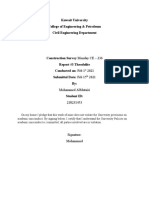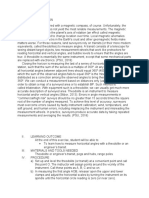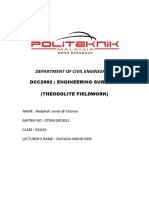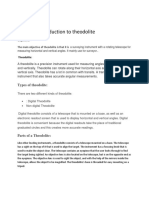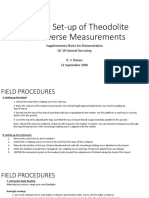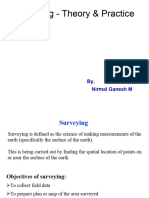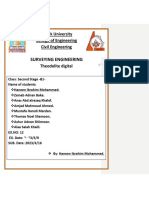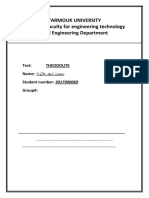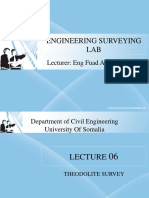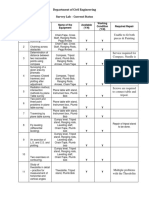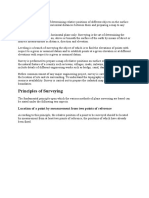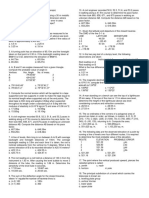TR111 GROUP 01 ASSIGNMENT
Uploaded by
jeremiahjohn653TR111 GROUP 01 ASSIGNMENT
Uploaded by
jeremiahjohn653UNIVERSITY OF DAR ES SALAAM
COLLEGE OF ENGINEERING AND TECHNOLOGY
DEPARTIMENT OF TRANSPORT AND GEOTECHNICAL
ENGINEERING
TR 111: ENGINEERING SURVEYING 1
PRACTICAL NO. 3: HORIZONTL ANGLE MEASUREMENT
GROUP NO. 01.
COARSE: BSCE.
S/N NAME REG. NO SIGNATURE
1 SENZIGE, ENEZA MEDARD 2024-04-10543
2 ILANI, JOANES PETRO 2024-04-02414
3 JOSEPH, JEREMIAH JOHN 2024-04-02835
4 KILUMILE, JAMES MELCHIZEDEK 2024-04-03836
5 RAMALE, JACKSON JULIUS 2024-04-09867
6 ELIHANGO, JACKLINE ISAAC 2024-04-01551
7 LIKALILO, JOHN DAVID 2024-04-04486
8 MASAKA, EMMANUEL JACKSON 2024-04-05622
9 TAIRO, JOEL JOSEPH 2024-04-11136
10 MWANKUNDA, JENIPHER JOSHUA 2024-04-08279
11 MEELA, RICHARD ROCKY 2024-04-12142
12 MBUBA, JIMISTONI JULIUS 2024-04-06176
Lecturer name: Dr.J.M. Mango
Field Supervisors:
Ms.A.S. Simon
Ms.S.A. Makuti
PRACTICAL DATE: 13/01/2025 Mr.H.K. Ismail
SUBMISSION DATE: 20/01/2025 Mr.G.J. Nchimbi
INTRODUCTION
This practical focuses on measuring horizontal angles using a theodolite. Involves setting up
and operating theodolite to measure angles between three survey stations, then identifying
quality of work, errors and ways to address them.
PRACTICAL OBJECTIVES
The main objectives of this practical exercise;
To understand basic functionality of the theodolite and to familize with the process of
setting up, adjusting and overall operation of the theodolite in the work field.
To measure the horizontal angle between three survey stations.
To analyses the errors in angular measurement and qualify survey work.
PRACTICAL TASK
To measure the horizontal angles between three survey stations. The measurements taken in
the field, and the results recorded for analysis.
EQUIPMENTS
Theodolite:
A modern, digital instrument for angle measurement.
Tripod
To stabilize the theodolite at a fixed height.
Three ranging poles
Tall, visible markers placed at survey stations to define specific locations and aid in
sighting. These poles help in aligning the instrument with the correct points for angle
measurements.
Three ranging pole stands
These securely hold the ranging poles in place, ensuring they remain stable and
accurately positioned during measurements.
Pegs
Used to mark and establish survey points on the ground, providing clear reference
positions for setting up theodolites and measuring angles.
Hammer
Used for driving the pegs into the ground to mark survey points, ensuring they are
firmly set for use throughout the survey.
Field book frame
Used to organize and protect the field book, where survey data, including angle
measurements and other observations, are recorded during the practical.
ADJUSTMENT OF THE EQUIPMENTS
The theodolite temporary adjusted by following the following procedures.
a) Set up the Tripod over the survey station and secure the theodolite.
b) Level the Instrument using levelling screws and the spirit level.
c) Align the Optical Plummet to centre over the survey point.
d) Re-check Alignment by rotating the instrument and adjust as needed.
e) Align with the reference direction.
FIELD PROCEDURE
1) Establishment of four points on the ground namely, X, Y and Z with distance of 40m
from P
1stset up: for measuring the interior angle XPY.
2) The theodolite temporary adjusted at P
3) Set up the ranging poles vertically at X, Y and Z
4) The theodolite oriented to X and then the angle between X and Y, between X and Z
measured and recorded considering FL and FR with initial angle of 15° at X for first
round and 30° at X for second round
2nd set up: Exterior angle measurement. Angle ZPX
5) The temporary adjusted theodolite at P oriented to Z station as reference line.
6) The angle ZPX measured considering FL and FR with initial angle of 15° at Z for first
round and 30° at Z for the second round
OPERATION
First theodolite set up (2 rounds)
The theodolite aligned to the first station (X), and the horizontal angle recorded.
The instrument then rotated to the next station (Y) and Z, and the angle between stations
X and Y, and X and Z measured and recorded.
Second theodolite set up (2 rounds)
Then theodolite aligned to Z station then angle between Z and X. Recorded.
SOURCE OF ERRORS
The following were sources of errors in horizontal angle measurement practical.
Instrument
Minor misalignments when setting up the theodolite cause slight discrepancies in angle
measurement.
Personal
Involves parallax errors, Misreading of scales or improper handling of the instrument
could contribute to inaccuracies.
Environmental
Wind and slight movements of the target object resulted to shifts in the sighting.
Ways to minimize.
By Conduct surveys under favourable environmental conditions.
By proper survey techniques and proper handling and use of equipment.
By Double-checking readings and calculations to ensure accuracy
RESULTS AND ANALYSIS
The results obtained have provided as an attachment of horizontal angle sheet.
CONCLUSION
Proper adjustment of the theodolite ensures accurate horizontal angle measurements by
minimizing errors and improving reliability. This leads to dependable data, contributing to the
success of surveying tasks.
RECOMMENDATIONS
Regular calibration and taking multiple angle readings are key to ensuring accurate
measurements. Proper training of surveyors and routine maintenance of equipment are essential
for reliable results. Environmental conditions should also be considered to minimize their
impact on measurements.
You might also like
- CONSTRUCTION OF A MODERN LADIES HOSTEL AT KENYA SCHOOL OF TVETNo ratings yetCONSTRUCTION OF A MODERN LADIES HOSTEL AT KENYA SCHOOL OF TVET36 pages
- Unit 6: Electronic Distance Measurement (EDM)No ratings yetUnit 6: Electronic Distance Measurement (EDM)29 pages
- Engineering Surveying Unit - 4: Theodolite100% (1)Engineering Surveying Unit - 4: Theodolite17 pages
- CE6304 Surveying 1 Question Bank Download Here75% (4)CE6304 Surveying 1 Question Bank Download Here12 pages
- TR111 HORIZONTAL ANGLE MEASUREMENTS II -2024No ratings yetTR111 HORIZONTAL ANGLE MEASUREMENTS II -20245 pages
- Kuwait University College of Engineering & Petroleum Civil Engineering DepartmentNo ratings yetKuwait University College of Engineering & Petroleum Civil Engineering Department7 pages
- Chapter 1 To Study 5 Second Theodolite: 1.1 Least CountNo ratings yetChapter 1 To Study 5 Second Theodolite: 1.1 Least Count51 pages
- M208 Vertical Angle Calibration TechniqueNo ratings yetM208 Vertical Angle Calibration Technique10 pages
- DEMO - Use and Set-Up of Theodolite For Traverse MeasurementsNo ratings yetDEMO - Use and Set-Up of Theodolite For Traverse Measurements3 pages
- Surveying Engineering: Kirkuk University College of Engineering Civil EngineeringNo ratings yetSurveying Engineering: Kirkuk University College of Engineering Civil Engineering11 pages
- Theodolite Device: Group Y DR: Mohamed AshrafNo ratings yetTheodolite Device: Group Y DR: Mohamed Ashraf15 pages
- Yarmouk University Al-Hijjawi Faculty For Engineering Technology Civil Engineering DepartmentNo ratings yetYarmouk University Al-Hijjawi Faculty For Engineering Technology Civil Engineering Department4 pages
- Surveying and Geomatics _2_1734949808648No ratings yetSurveying and Geomatics _2_173494980864861 pages
- Sun and Earth Modern User Reference Guide: Determining earth’s true surface shape as flat using the sunFrom EverandSun and Earth Modern User Reference Guide: Determining earth’s true surface shape as flat using the sunNo ratings yet
- Remote Sensing & Geospatial Technologies Dictionary: Grow Your Vocabulary, #55From EverandRemote Sensing & Geospatial Technologies Dictionary: Grow Your Vocabulary, #55No ratings yet
- Plane and Geodetic Surveying For Engineers100% (2)Plane and Geodetic Surveying For Engineers650 pages
- Engineering Surveying LAB: Lecturer: Eng Fuad Abdirizak ElmiNo ratings yetEngineering Surveying LAB: Lecturer: Eng Fuad Abdirizak Elmi38 pages
- Handout # 4 Traverse Surveying Ce103 2017No ratings yetHandout # 4 Traverse Surveying Ce103 20176 pages
- Basic Civil Engineering- SURVEYING-FinalNo ratings yetBasic Civil Engineering- SURVEYING-Final97 pages
- Sample Chapter On Optical and Surveying Instruments100% (4)Sample Chapter On Optical and Surveying Instruments23 pages
- Department of Civil Engineering Survey Lab - Current StatusNo ratings yetDepartment of Civil Engineering Survey Lab - Current Status4 pages
- IES 2012 Exam Civil Engineering Paper II Solved With Answer Key0% (2)IES 2012 Exam Civil Engineering Paper II Solved With Answer Key21 pages
- Azimuth Determination of A Line by Observation of The Sun at Equal AltitudeNo ratings yetAzimuth Determination of A Line by Observation of The Sun at Equal Altitude4 pages
- Development Camera Calibration Methods ModelsNo ratings yetDevelopment Camera Calibration Methods Models16 pages
- Construction Surveying Fundamentals ASSIGNMENT 80% (1)Construction Surveying Fundamentals ASSIGNMENT 83 pages
- CE6413 Survey Practical II Lab Manual PDFNo ratings yetCE6413 Survey Practical II Lab Manual PDF41 pages
- Principles of Surveying: Location of A Point by Measurement From Two Points of ReferenceNo ratings yetPrinciples of Surveying: Location of A Point by Measurement From Two Points of Reference9 pages
- Ceornt120 History of Ce in The PhilippinesNo ratings yetCeornt120 History of Ce in The Philippines12 pages
- T207 Verticle Angle Calibration Fo A TheodoliteNo ratings yetT207 Verticle Angle Calibration Fo A Theodolite11 pages











